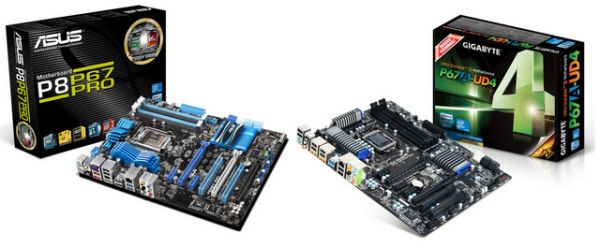The Battle of the P67 Boards - ASUS vs. Gigabyte at $190
by Ian Cutress on January 20, 2011 4:15 PM EST- Posted in
- Motherboards
- Gigabyte
- Asus
- P67
Final Words
Both the ASUS P8P67 Pro and Gigabyte P67A-UD4 motherboards offer a lot to consumers. For $190, we want a product that hits all the basic functionality of Sandy Bridge, and squeezes out as features and as much performance as possible at this price point.
For the ASUS board, we have a nice looking product with significant strengths in the implementation of their UEFI, and the auto overclockable functions available. The UEFI EZ mode/basic starting screen is something many manufacturers will copy over the upcoming months and UEFI visions. The auto-tuner section of Ai Suite will see use in all markets, aiding various retailers in offering ready-overclocked Sandy Bridge bundles with the P8P67 Pro. Intel gigabit Ethernet is nothing to be sniffed at, and the fan controls can only help improve the user experience. Also, bundle in that three-year warranty. On the downside, the BT GO! and Turbo Remote overclocking features via Bluetooth did not work for me.
The Gigabyte board performs on par with the ASUS board in terms of benchmarking – in most situations, there is almost nothing in it (except USB, where Gigabyte have the advantage there). The board is UEFI GUI absent (for now, supposedly), but thanks to BIOS updates, now supports 2.2TB+ hard drives. Overclocking via the BIOS is straightforward if you have ever overclocked before, and the myriad of software available in the OS will keep you hunting for options, trying to remember which setting is in which piece of software. The warranty, like the ASUS, is also three years. However, the BIOS updating issues I had are certainly worthy of note.
After playing with both boards, I can only come to one conclusion – if it were my money, I would take the ASUS P8P67 Pro over the Gigabyte P67A-UD4. With the ASUS board, you are getting a detailed UEFI, an awesome auto-overclocking tool, better energy saving features, a USB 3.0 bracket , more SATA 6 Gb/s ports, Intel gigabit Ethernet, and in my case, scope for a better overclock. The Gigabyte board is essentially expensive for what is on offer, in terms of usability, features, and extras.
However, the second question is: ‘what about the comparison to the ASRock P67 Extreme4’? The ASRock board has power/reset buttons on the board, a Debug LED, that USB 3.0 bracket which will hold an SSD (worth in my option about $15), and is almost $40 cheaper. The ASUS board is the slightly better performing, overclocking is easier on the ASUS, the ASUS has a longer warranty, the UEFI is slightly better on the ASUS, the ASUS uses Intel Ethernet rather than Realtek, but the ASRock will take socket 775 coolers. It is up to you to judge, but in my opinion, I would take the Extreme4, pocket the $40 difference, and invest it in something else for a PC build.
This then leads into the following question – ‘if I’d rather take a $150 board rather than a $190 board, why are there $300 boards available?’ That question is to be tackled over the coming months!











137 Comments
View All Comments
Tommieemict - Wednesday, June 10, 2020 - link
nude teen sisters on periods https://teenwebcams00.uno">teenwebcams00.uno chubby indian teen nude.CarsonJoine - Wednesday, June 10, 2020 - link
naked mature selfie tits https://maturewebcams00.space">mature wife fuck tube mature fucked at massage.milf sucking teen cock https://milfwebcams00.casa">milfwebcams00.casa homies fuck white milf dp.
amateur big tit teen casting https://amateurwebcams00.xyz">amateurwebcams00.xyz amateur good looking black couple fuck.
2018 black ameature porn in hd https://blackwebcams00.icu">blackwebcams00 black amateur guy fucking amateur mexican girl.
sexy mature latina porn https://maturewebcams00.space">maturewebcams00.space thick huge tit mature pics.
JamesSag - Thursday, June 11, 2020 - link
lesbian initiation rite video https://lesbianwebcams01.fun">lesbianwebcams01.fun vintage lesbian porn gifs.moms gone black porn https://blackwebcams00.icu">pimp wife black men porn lets fuck black pussy couple porn.
gay black porn inetrracil threesomes https://blackwebcams00.icu">blackwebcams00 black nude model art.
dick an jane mature couple tumblr https://maturewebcams00.space">maturewebcams00.space gay mature tumblr masturbation.
two teens caught in pool fuck https://teenwebcams00.uno">petite teen creampie porn curvy teen girl nude strip.
Michaelsok - Friday, June 12, 2020 - link
video asian milf seduces me sex https://asianwebcams00.host">indian boss kissing and sex with receptionist fuck unconscious japanese business woman video.BrianSat - Friday, June 12, 2020 - link
sexy lesbian mom footrub https://lesbianwebcams00.fun">lesbianwebcams00.fun lesbian bondage training porn.hd milf ffm porn https://milfwebcams00.casa">hot thick milf pinterest perfect boobs milf fuck.
fucking a drunk milf https://milfwebcams00.club">milf boss fucks male employee milf monster cock creampie.
Mature blonde gang-raped on a couch https://maturewebcams00.club">maturewebcams00 young old russian mature sex.
white ass black dick https://blackwebcams00.pw">blackwebcams00.pw sexy ebony lesbian threesome.
Steveunfah - Sunday, June 14, 2020 - link
indian wife nude orgy outdoor https://asianwebcams00.host">massive asian tits tumblr asian teen fucks boyfriends friend.mary jane scott college girls nude https://collegewebcams00.store">naked college girl sex college girl rides cock gif.
chubby anal bbc amateur https://amateurwebcams00.monster">amateurwebcams00 amateur milf riding big cock creampie.
milf big ass anal https://milfwebcams00.casa">milf wants young cock gif milf next door naked.
asian fucking for a long time https://asianwebcams00.host">hot naked japanese women thai lan hd sex.
JamesSmant - Monday, June 15, 2020 - link
big hairy college cock https://collegewebcams00.store">collegewebcams00.store college girl masturbation color hidden.